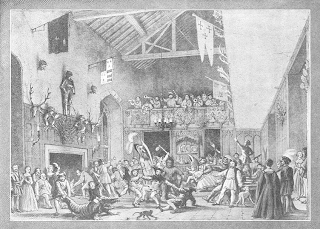The DVD for the 1981 version of Sense & Sensibility has been sitting on my dresser since January, when my husband had his stroke. Once in a while, I’d notice it and think about sending it back to Netflix and lowering our service to 1 DVD a month, but I kept hoping to get a chance to watch it.
Anyway, last week I finally got my chance. My younger daughter decided to reuse the Felicity (American girl) costume I’d made for her older sister a few years ago, which was nice. But the older one wanted to stay in theme and go as Abigail Adams. See, Megan has the cool kid, while mine are nerdy, though in a cool way, I think. 🙂
Hoping to save time, I bought an old prom dress at Salvation Army, telling myself that changing the sleeves and shortening the hem would be easier than sewing a new gown. Ha! Not only did I have to make new sleeves, I had to redo the bodice and since I wanted to preserve the ruffle at the hem, I had to detach the bodice from the skirt, etc… Well, you get the picture. I was up late sewing for a few nights before Halloween and decided the S&S DVD would help me stay awake.
I’m pretty much an Austen adaptation ho—there are few versions I don’t like. Unfortunately this is one of the few.
The script was clunky, IMHO, showing little of Jane’s wit or liveliness. There were scenes with minor characters that seemed thrown in for no obvious reason (I don’t remember if they were in the book). The pacing was slow, except for the rushed ending in which we were gypped of seeing the resolution of Marianne and Colonel Brandon’s romance.
 To my mind, the worst problem was with the characterization of the two sisters. The differences between the two sisters were exaggerated to the point that they became one-dimensional: Elinor coldly robotic, Marianne spoiled rotten. When Marianne gets overly dramatic about her feelings on leaving Norland, Elinor is almost cruel in dismissing the real emotions underlying her sister’s dramatics. I really couldn’t care much about either of them.
To my mind, the worst problem was with the characterization of the two sisters. The differences between the two sisters were exaggerated to the point that they became one-dimensional: Elinor coldly robotic, Marianne spoiled rotten. When Marianne gets overly dramatic about her feelings on leaving Norland, Elinor is almost cruel in dismissing the real emotions underlying her sister’s dramatics. I really couldn’t care much about either of them.
It seems to me that some of the Austen adaptations of this period, though they seem to be attempting to be painstakingly accurate, are so busy hallowing Jane that they miss out on wit and vitality of her work and characters. They seem to carefully eschew anything that might look like sexual attraction. Some subtle sexual tension would be very much in the spirit of the books, IMHO. I think some of the more recent adaptations work better, even if they don’t follow the books as slavishly.
One thing I did like about this version is the simple look of the interiors and the clothing, which seemed like what the Dashwood girls could afford rather getting a glamorized Hollywood treatment.
But overall, I prefer either the Emma Thompson or last year’s BBC version to this one. I’d recommend it only if you are like me and feel compelled to see every Austen adaptation out there.
So has anyone else seen this version? What did you think? What approach to Austen film adaptations do you like best?
Elena
www.elenagreene.com






